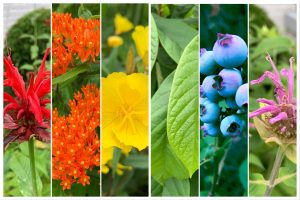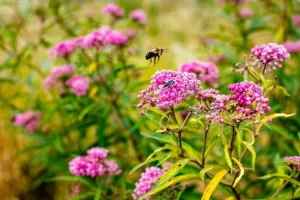Gardening is more than just a hobby; Our connection with nature allows us to create beauty and make a positive contribution to the environment. One of the most valuable types of gardens you can design is a native plant garden. Native plants are plants that grow naturally in a specific area and have adapted to the local climate and soil conditions over thousands of years. These plants have many benefits, from conserving water to supporting local wildlife. In this article, we will guide you through the process of designing a native plant garden.
Benefits of Native Plants
Before diving into the design process, it’s worth understanding why native plants are a good choice for your garden:
- Water efficiency: Native plants adapt well to local rainfall patterns, reducing the need for irrigation once established. This saves money on your water bill and helps conserve this precious resource.
- Low Maintenance: Native plants generally require less maintenance than exotic plants. They are naturally resistant to local diseases and pests, saving you time and money on pesticides and fertilizers.
- Wildlife Habitat: Native plants provide food and shelter for local wildlife, including birds, butterflies, and bees. By planting native plants you can create a thriving ecosystem in your own backyard.
- Biodiversity: Using native plants in your garden helps protect and promote local biodiversity. Many native species are endangered or threatened, and by including them in your garden you can contribute to their conservation.
Steps for Designing a Native Plant Garden
- Research local native plants: Start researching the native plant species that thrive in your area. Visit a local nursery, or botanical garden or consult the resources available at your local agricultural extension office. Knowing which plants are native to your region is critical to the success of your garden.
- Assess the space in your garden: Assess the conditions in your garden, including sun exposure, soil type, and drainage. Different native plants have specific requirements, so matching them to the conditions in your garden is critical to their survival.
- Choose a design theme: Determine a design theme for your native plant garden. Are you going for a wild, natural look or do you prefer a structured, formal design? Your theme will determine your plant selection and layout.
- Choose a Variety of Native Plants: Choose a variety of native plants to ensure year-round interest and support for local wildlife. Add different heights, colors, and bloom times to create a visually appealing garden.
- Planting and Maintenance: Follow best practices for growing native plants and be sure to water regularly for the first year so they can establish deep roots. After that, native plants usually require minimal maintenance.
- Patience and observation: It can take some time for native plant gardens to reach their full potential. Be patient and see how it changes with the seasons. You get a garden that not only looks beautiful but also makes a positive contribution to the environment.
Garden Maintenance Tips
Once you have established a native plant garden, it must be properly maintained to ensure its continued health and beauty. Here are some maintenance tips to remember:
- Watering: Native plants are generally more drought tolerant than non-native plants, but they still need water, especially during the first year or during extended droughts. Water deeply but infrequently to promote deep root growth and reduce the need for frequent watering.
- Mulch: Apply a layer of organic mulch around native plants. Mulch helps retain soil moisture, suppress weeds and regulate soil temperature. Avoid piling mulch directly on plant stems to prevent rot.
- Pruning and decapitating: Prune native plants regularly to maintain their shape and remove dead or diseased growth. Decapitating or removing blooms from flowers can promote more blooms and prevent self-flowering in some varieties.
- Fertilizer: Most native plants do not require heavy fertilization. Excessive fertilizer can actually harm them. If your soil is nutrient-deficient, consider using a low-nitrogen, slow-release fertilizer sparingly and always following recommended guidelines.
- Pest and disease management: Native plants are often more resistant to local pests and diseases. However, keep an eye out for any signs of problems and resolve them immediately using organic and environmentally friendly methods where possible.
- Enjoy nature: One of the joys of a native plant garden is seeing the local wildlife flourish. Be patient and observe the birds, bees, butterflies, and other creatures that visit your garden. Providing a water source, such as a birdbath, can attract more wildlife.
Share the Beauty of Native Plants
Your native plant garden can serve as a source of inspiration and education for your community. Consider organizing a garden tour, or workshop, or attending a local environmental event to share your passion for native plants with others. By doing this, you can help people realize how important it is to use native species in their landscaping.
Conclusion
Designing and maintaining a native plant garden is a great way to connect with nature and have a positive impact on the local environment. By choosing native plants you can help protect biodiversity, conserve water, and create a haven for wildlife. Furthermore, the beauty of a well-designed native botanical garden is a reward in itself.
So as you embark on the journey of creating and cultivating a native plant garden, remember that you are not just gardening; You express your commitment to the environment and your appreciation for the natural world. Enjoy the process and may your garden bloom with its original beauty for years to come.
FAQs
1. What are native plants?
Native plants are plants that grow naturally in a specific area and have adapted over time to the local climate, soil, and environmental conditions. They are ideal for the area and support the local wildlife.
2. Why should I consider starting a native garden?
Creating a native garden has many benefits, including conserving water, reducing maintenance, supporting local wildlife, and protecting biodiversity. Native gardens can also be visually appealing and make a positive contribution to the environment.
3. How do I choose the right native plants for my garden?
Research the native plant species that thrive in your specific area. Resources at local nurseries, botanical gardens, and agricultural extension offices can provide valuable information. When choosing plants, consider the conditions in your garden, such as sunlight, soil type and drainage.
4. When is the best time to plant native plants?
Fall and early spring are often the best times to plant native species. This allows them to take root before hot summers or cold winters.
5. Do native gardens require less maintenance?
Yes, native gardens generally require less maintenance than gardens with non-native plants. Native species adapt to local conditions, making them more resistant to diseases and pests. However, some maintenance, such as watering and occasional pruning during the first year, is still necessary.



